Text


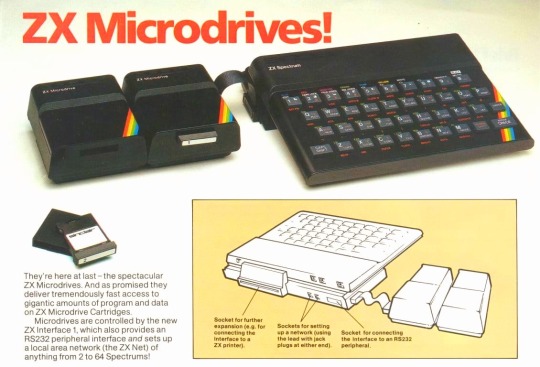
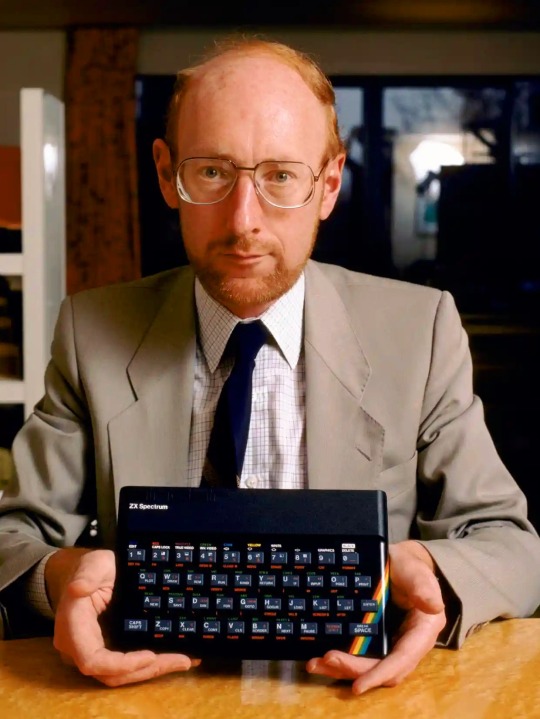


🇬🇧 Immerse yourself in the captivating world of computing through the Sinclair ZX Spectrum—a groundbreaking microcomputer that captured the imagination of an entire generation!
🌟 In 1980, the visionary British entrepreneur and scientist, Sir Clive Sinclair, entered the home computer market with the ZX80 priced at £99.95, marking the era's most affordable personal computer in the United Kingdom. A year later, the ZX81 hit the high street, introducing home computing to a generation, with over 1.5 million units sold.
💻 Released in 1982 by Sinclair Research Ltd., the Sinclair ZX Spectrum swiftly became one of the most iconic home computers of its time. It dominated the UK's computer sales market, fiercely competing against Commodore and Amstrad. This compact and budget-friendly machine brought computing into countless households.
🕹️ Powered by the Zilog Z80A CPU running at 3.5 MHz and equipped with either 16 KB or 48 KB of RAM, the ZX Spectrum sported a sleek, compact design resembling a keyboard with rubber keys, making it innovative and approachable. Its graphics and sound capabilities were ahead of their time, enabling vibrant games and applications.
⌨️ One of the ZX Spectrum's standout features was its vast library of games. From classics like "Manic Miner" and "Jet Set Willy" to innovative titles developed by enthusiasts, the Spectrum's game collection remains a cherished part of gaming history. The computer's BASIC programming language also inspired users to create their own software.
🖥 Despite modest hardware specifications, the ZX Spectrum nurtured a lively community of developers and enthusiasts, serving as a gateway into the world of programming and digital creativity.
🚀 Over its lifespan, the ZX Spectrum evolved with new models, including the ZX Spectrum+, ZX Spectrum 128, and ZX Spectrum +2, each offering enhanced performance and features while retaining the beloved design.
📺 The ZX Spectrum's impact extended beyond its hardware, playing a pivotal role in the British computing scene, inspiring future generations of programmers and entrepreneurs. Its legacy resonates in modern computing and gaming through emulators and remakes that keep its spirit alive.
📊 At the peak of its success and largely inspired by the Japanese Fifth Generation Computer program, the company established the "MetaLab" research centre at Milton Hall near Cambridge to pursue advanced projects like artificial intelligence, wafer-scale integration, and formal verification.
💔 Financial difficulties in 1985, brought on by the failures of the Sinclair QL computer and the TV80 pocket television, led Sinclair to sell the rights to its computer products and brand name to Amstrad in 1986. Sinclair Research Ltd continued as a one-man company, marketing Clive Sinclair's inventions until his passing in September 2021.
#techtime chronicles#old technology#companies#tech#technology#old tech#technews#information technology#corporations#electronics#sinclair research ltd#sinclair#zx spectrum#spectrum#england#british computing#computer legacy#computer science#computing#computers#computer#retro gaming#gaming#video games#innovation#amstrad#metalab#hardware#software#zilog
9 notes
·
View notes
Text

🎉 Thank you @mosdefftheprez and everyone who got me to 50 reblogs!
🙋♂️ Welcome to TechTime Chronicles: Journey Through Electronics & Gadgets History!

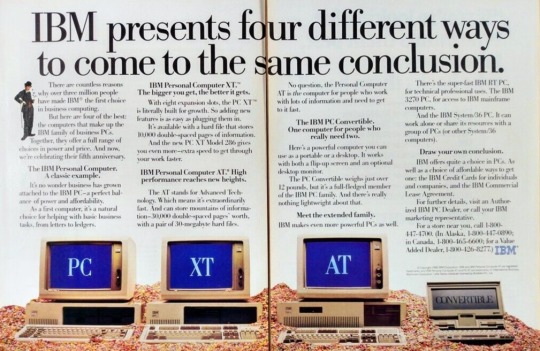


🇺🇸 Step back in time to 1986 and witness the dawn of a revolutionary device—the IBM PC Convertible. As one of the earliest portable computers, the PC Convertible marked a significant milestone in the evolution of American personal computing, offering newfound mobility and versatility to professionals and enthusiasts alike.
💻 The IBM PC Convertible represented IBM's inaugural foray into creating a portable version of its iconic PC line. It was the first laptop-style computer following the luggable IBM Portable, and notably introduced the 3½-inch floppy disk format to the IBM product line. Featuring a clamshell design this groundbreaking device set the stage for future generations of laptops. Its compact form factor and relatively lightweight made it a practical choice for on-the-go computing—a novel concept at the time.
⌨️ Unlike earlier portable computers that required external keyboards, the PC Convertible boasted a built-in keyboard, enhancing its usability and convenience.
👉 The PC Convertible came in three models: PC Convertible, PC Convertible Model 2, and Model 3. The latter two were released in October 1987 and are primarily distinguished by their LCD panels. The original Convertible used a non-backlit panel, which was considered difficult to read. The Model 2 lacked a backlight as well but upgraded to an improved supertwist panel, while the Model 3 included a backlight.
🖥️ Equipped with an innovative flip-up monochrome, CGA-compatible LCD screen, the PC Convertible offered a crisp display for viewing documents and running applications—a revolutionary feature for its time.
💾 Powered by an Intel 80C88 CPU, the PC Convertible came with built-in storage options, including 256 KB of RAM (expandable to 640 KB) and dual 720 KB 3.5-inch floppy drives, enabling users to store and access data with ease. It also featured serial and parallel ports for connecting peripherals.
🔋 Despite its modest battery life by today's standards, the PC Convertible offered respectable uptime, allowing users to work on the go without being tethered to a power source. Weighing just over 12 pounds and featuring a built-in carrying handle, the PC Convertible's battery was rated for 10 hours.
🌟 The IBM PC Convertible was succeeded in 1991 by the PS/2 L40 SX, and in Japan by the IBM Personal System/55note, the predecessor to the ThinkPad. The IBM PC Convertible left an indelible mark on the history of computing, paving the way for the modern laptops we use today. Its innovative design and practical features demonstrated the potential of portable computing, inspiring subsequent advancements in mobile technology.
#50 reblogs#tumblr milestone#thank you#old technology#companies#techtime chronicles#tech#old tech#technology#information technology#technews#electronics#corporations#computer science#computing#retro tech#retro#it#ibm#laptops#laptop#pc#computers#computer#high tech#industry#engineering#business#commodore#apple computers
49 notes
·
View notes
Text




🇺🇸 Step back in time to 1986 and witness the dawn of a revolutionary device—the IBM PC Convertible. As one of the earliest portable computers, the PC Convertible marked a significant milestone in the evolution of American personal computing, offering newfound mobility and versatility to professionals and enthusiasts alike.
💻 The IBM PC Convertible represented IBM's inaugural foray into creating a portable version of its iconic PC line. It was the first laptop-style computer following the luggable IBM Portable, and notably introduced the 3½-inch floppy disk format to the IBM product line. Featuring a clamshell design this groundbreaking device set the stage for future generations of laptops. Its compact form factor and relatively lightweight made it a practical choice for on-the-go computing—a novel concept at the time.
⌨️ Unlike earlier portable computers that required external keyboards, the PC Convertible boasted a built-in keyboard, enhancing its usability and convenience.
👉 The PC Convertible came in three models: PC Convertible, PC Convertible Model 2, and Model 3. The latter two were released in October 1987 and are primarily distinguished by their LCD panels. The original Convertible used a non-backlit panel, which was considered difficult to read. The Model 2 lacked a backlight as well but upgraded to an improved supertwist panel, while the Model 3 included a backlight.
🖥️ Equipped with an innovative flip-up monochrome, CGA-compatible LCD screen, the PC Convertible offered a crisp display for viewing documents and running applications—a revolutionary feature for its time.
💾 Powered by an Intel 80C88 CPU, the PC Convertible came with built-in storage options, including 256 KB of RAM (expandable to 640 KB) and dual 720 KB 3.5-inch floppy drives, enabling users to store and access data with ease. It also featured serial and parallel ports for connecting peripherals.
🔋 Despite its modest battery life by today's standards, the PC Convertible offered respectable uptime, allowing users to work on the go without being tethered to a power source. Weighing just over 12 pounds and featuring a built-in carrying handle, the PC Convertible's battery was rated for 10 hours.
🌟 The IBM PC Convertible was succeeded in 1991 by the PS/2 L40 SX, and in Japan by the IBM Personal System/55note, the predecessor to the ThinkPad. The IBM PC Convertible left an indelible mark on the history of computing, paving the way for the modern laptops we use today. Its innovative design and practical features demonstrated the potential of portable computing, inspiring subsequent advancements in mobile technology.
#old technology#techtime chronicles#companies#tech#technology#old tech#technews#information technology#corporations#electronics#ibm#ibm corporation#ibm pc1#ibm pc#ibm pc convertible#laptops#laptop#computer science#computing#computers#computer#old computers#hardware#software#innovation#made in america#made in usa#floppy disk#thinkpad#ibm pc-line
49 notes
·
View notes
Text

🎉 25 posts!
🙋♂️ Welcome to TechTime Chronicles: Journey Through Electronics & Gadgets History!
💾 Explore the past, present & future of tech!
#25 posts#tumblr milestone#old technology#techtime chronicles#companies#technology#tech#technews#old tech#information technology#corporations#electronics#ibm corporation#toshiba t1100#toshiba#laptops#computer science#computing#robotization#robotics#robots#robot#retro tech#apple computers#microsoft#lenovo#thinkpad#y2k#y2k style#gadgets
2 notes
·
View notes
Text
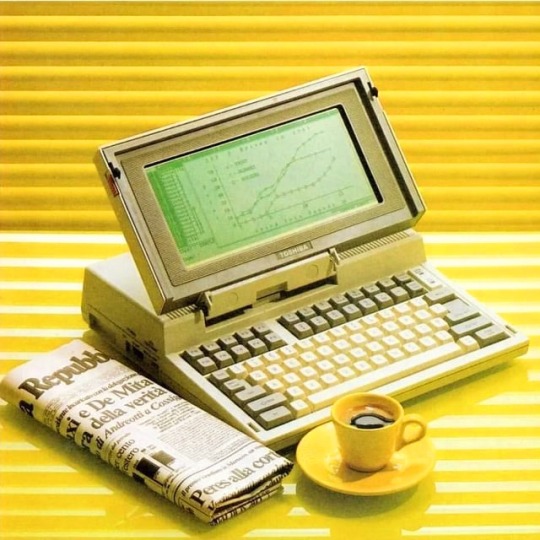




🇯🇵 Unveiling the Toshiba T1100: A Journey into the Dawn of Portable Computing!
💻 In the early 1980s, a revolutionary device emerged, transforming the landscape of personal computing forever. The Toshiba T1100, released in 1985, marked a significant milestone in the history of portable computers. The Toshiba T1100 has subsequently been described by Toshiba as "the world's first mass-market laptop computer".
🌐 The Toshiba T1100 was among the first truly portable computers, designed for professionals and enthusiasts seeking computing power on the go. Weighing approximately 4.1 kilograms (9 pounds) with its lead-acid battery, this innovative machine provided users with unprecedented mobility.
⚙️ Equipped with an Intel 80C88 processor running at 4.77 MHz and boasting 256 KB of RAM, the Toshiba T1100 offered impressive computing capabilities for its time. Its 9.6-inch monochrome LCD screen provided a crisp display, while the detachable keyboard enhanced usability.
💾 The T1100 introduced several innovative features, including a built-in 3.5-inch floppy disk drive—a rarity at the time—which allowed for data storage and transfer with ease. This model also featured MS-DOS as its operating system, providing a familiar computing environment.
📈 The Toshiba T1100 set a new standard for portable computing, demonstrating the feasibility and practicality of laptops for business and personal use. Its success paved the way for subsequent generations of laptops, influencing the evolution of mobile computing worldwide.
👨💻 For professionals in various industries, the Toshiba T1100 represented a game-changer, enabling efficient data management, word processing, and spreadsheet tasks on the move. Its portability and functionality empowered users to work beyond traditional office environments.
🌟 Today, the legacy of the Toshiba T1100 lives on in the sleek, lightweight laptops and notebooks that have become indispensable tools for modern professionals and digital nomads. This groundbreaking device remains a testament to Toshiba's commitment to innovation and excellence in the field of computing. The Toshiba T1100 remains an iconic symbol of the dawn of portable computing—a chapter in the ongoing story of technological progress that continues to shape our digital world.
#old technology#techtime chronicles#companies#tech#technology#old tech#technews#information technology#corporations#electronics#toshiba#t1100#toshiba t1100#laptop#laptops#portable computer#computer science#computing#computers#computer#hardware#software#1980s computers#1980s#innovation#made in japan#japan#retro tech#tech review#pc
14 notes
·
View notes
Text
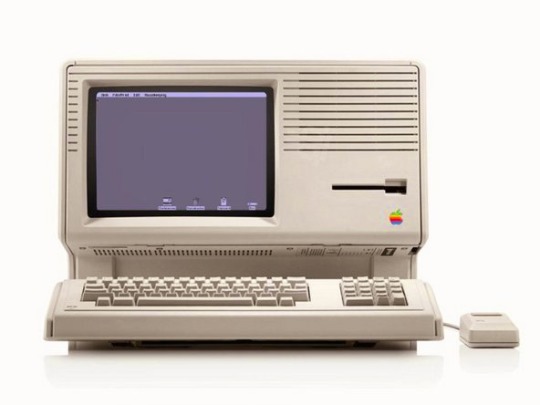

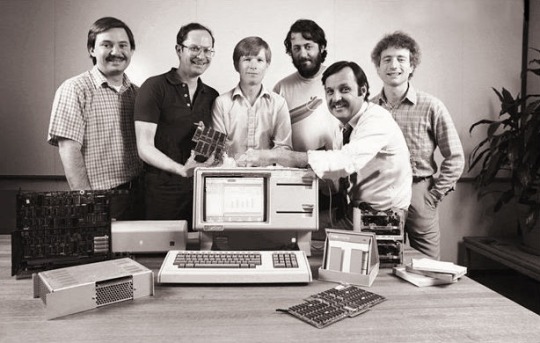

🇺🇲 Embark on a journey through the revolutionary history of the Apple Lisa—a groundbreaking computer that paved the way for modern computing as we know it!
🍏 The Apple Lisa, introduced in 1983, was a landmark achievement in the world of personal computing. Developed by Apple Inc., it was named after Steve Jobs' daughter, Lisa. This innovative machine was one of the first to feature a graphical user interface (GUI) and a mouse, making it incredibly intuitive and user-friendly.
💻 The Apple Lisa was designed to cater to the needs of business professionals, offering advanced features and capabilities that were unparalleled at the time. Its GUI allowed users to interact with the computer using icons and windows, revolutionizing the way people interacted with technology.
💾 Under the hood, the Apple Lisa boasted impressive specifications for its time, including a Motorola 68000 processor running at 5 MHz, up to 2 MB of RAM, and a high-resolution display. It also featured innovative software such as LisaDraw, LisaWrite, and LisaCalc, which provided users with powerful tools for productivity and creativity.
💡 Despite its groundbreaking features, the Apple Lisa faced challenges in the market due to its high price tag and competition from other manufacturers. However, its legacy lived on, paving the way for future innovations in personal computing.
📈 The Apple Lisa may not have been a commercial success, but its impact on the industry was profound. Many of its features and technologies would later be incorporated into the iconic Macintosh, which would go on to become one of the most influential computers of all time.
🚀 Today, the Apple Lisa is remembered as a symbol of innovation and forward-thinking design. Its legacy continues to inspire generations of computer enthusiasts and serves as a reminder of the transformative power of technology. As we look back on the history of computing, let us not forget the pioneering spirit of the Apple Lisa and the role it played in shaping the digital world we know today.
#old technology#companies#tech#techtime chronicles#technews#technology#information technology#old tech#corporations#electronics#apple computers#apple#apple lisa#steve jobs#steve jobs's legacy#computer science#computing#computers#computer#old computers#retro tech#hardware#software#software development#innovation#industry#made in usa#digital#design#motorola
7 notes
·
View notes
Text
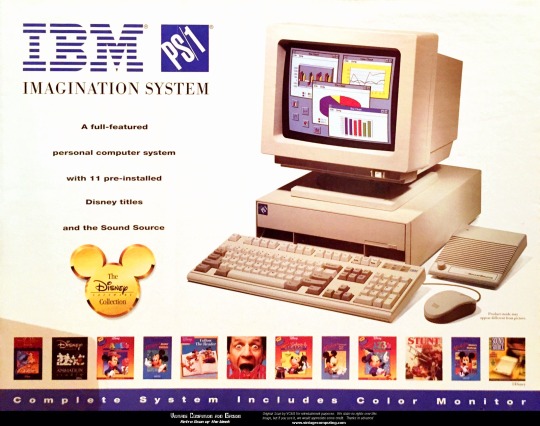


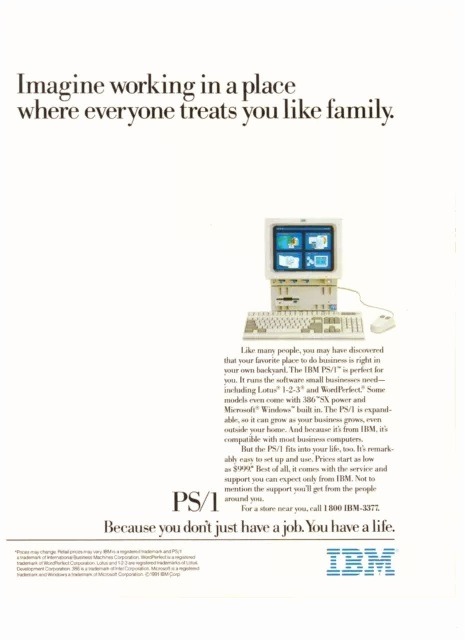
🇺🇲 Step back in time and explore the fascinating journey of the IBM PS/1—a pioneering computer that revolutionized personal computing in the late 1980s and early 1990s!
💻 The IBM PS/1, short for Personal System/1, marked a significant milestone in the evolution of home computing. Launched by IBM in 1990, this innovative machine was designed to bring the power and versatility of IBM's business computers into the homes of consumers.
💾 With its sleek and compact design, the IBM PS/1 was a departure from the bulky and intimidating computers of the past. It featured a built-in monitor, keyboard, and mouse, making it a convenient all-in-one solution for home users.
⚙️ Under the hood, the IBM PS/1 boasted impressive specifications for its time, including an Intel 80286 or 80386 processor, up to 16MB of RAM, and a variety of storage options ranging from floppy disks to hard drives. This formidable hardware allowed users to run productivity software, play games, and explore the emerging world of multimedia with ease.
💡 One of the most notable features of the IBM PS/1 was its user-friendly interface, which made it accessible to users of all skill levels. With its intuitive graphical user interface and pre-installed software, including IBM's own software suite and educational programs, the IBM PS/1 opened up new possibilities for home computing.
📈 Despite facing stiff competition from other manufacturers, the IBM PS/1 enjoyed moderate success and helped pave the way for the widespread adoption of personal computers in homes around the world. Its influence can still be felt today in the countless households that rely on computers for work, entertainment, and communication.
🚀 The IBM PS/1 may have been a product of its time, but its legacy lives on as a testament to the transformative power of technology. As we continue to push the boundaries of computing, let us not forget the humble beginnings of the IBM PS/1 and the role it played in shaping the digital world we know today.
#old technology#techtime chronicles#companies#tech#technology#old tech#technews#information technology#corporations#electronics#ibm pc1#ibm pc#ibm#ibm corporation#computer science#computing#computers#made in america#made in usa#intel 80286#intel#intel 80386#hardware#software#software development#computer#floppy disk#innovation#information#user interface
5 notes
·
View notes
Text


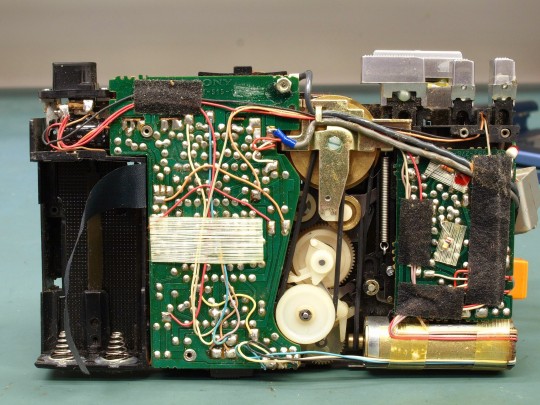



🇯🇵 Step back in time and discover the iconic journey of the 1979 Sony Walkman TPS-L2, a groundbreaking innovation that revolutionized the way we listen to music on the go!
🎶 Walkman, stylised as WALKMAN (ウォークマン), is a brand of portable audio players manufactured and marketed by Japanese company Sony since 1979. The original Walkman started out as a portable cassette player and the brand was later extended to serve most of Sony's portable audio devices; since 2011 it consists exclusively of digital flash memory players.
📼 Released in 1979 by Sony Corporation, the Walkman TPS-L2 marked a significant milestone in portable audio technology. Designed by Sony's audio division head, Nobutoshi Kihara, the Walkman aimed to provide music lovers with the freedom to enjoy their favorite tunes anywhere, anytime.
🔊 The Walkman TPS-L2 allowed users to listen to cassette tapes through lightweight headphones, offering a personal and immersive listening experience on the move. With its compact size and innovative design, the Walkman quickly became a cultural phenomenon, sparking a global craze for portable music players.
🎼 The success of the Walkman TPS-L2 catapulted Sony to the forefront of the consumer electronics industry and cemented its reputation as a pioneer in portable audio technology. Its influence extended beyond music, shaping the way people interacted with technology and consumed media in their daily lives.
💽 Despite the emergence of digital music players and streaming services in recent years, the Walkman TPS-L2 remains a beloved icon of the analog era, cherished by collectors and enthusiasts alike for its role in shaping the way we experience music on the go.
#retro tech#old technology#techtime chronicles#companies#tech#technology#old tech#technews#corporations#electronics#sony corporation#sony#made in japan#walkman#player#music#audio cassette#audio#brands#portable devices#device#gadgets#audio production#innovation#innovative#timeless#history#design#technoblade#japan
5 notes
·
View notes
Text



🇯🇵 Explore the captivating history of the Sony Vaio 505 series, a pioneering lineup of laptops that revolutionized the world of computing!
💻 The Sony Vaio 505 (called SuperSlim until 2003) series was a line of ultraportable notebook computers from Sony's VAIO brand. The laptop made its debut in 1997, marking Sony's foray into the realm of portable computing. The introduction date in the United States was July 24, 1998. Designed to be sleek, stylish, and powerful, these laptops quickly became synonymous with cutting-edge technology and premium craftsmanship.
⚙️ Engineered with precision and attention to detail, the Sony Vaio 505 series boasted innovative features and state-of-the-art components. Hardware specifications at introduction were a 200 MHz or 266 MHz Pentium MMX CPU, 32 MB RAM, a 2.1 GB hard drive, 10.4" SVGA (800x600) screen, integrated sound, modem, speakers, microphone, PC-Card slot, and optional firewire port. It also featured a touchpad with additional pen functionality. The weight was 3.1 lbs.
👉 In addition to the 10.4" models, a 12.1" 505 Superslim Pro was introduced in April 1999, weighing 3.75 lbs (1.7 kg), and featuring 1024x768 screen. Starting from the R505 revision (2001), the laptops were supplied with a docking station with integrated CDRW/DVD drive. From R505D onwards, 802.11B wireless was integrated. From vibrant displays to powerful processors, these laptops were ahead of their time, setting new standards for performance and reliability in the industry.
🌟 The Vaio 505 series was renowned for its slim and lightweight design, making it ideal for professionals on the go. With a focus on portability without compromising on power, these laptops were well-suited for business users, students, and creative professionals alike.
➡️ Over the years, the Sony Vaio 505 series continued to evolve, with each new iteration pushing the boundaries of what was possible in laptop design and functionality. From enhanced graphics capabilities to improved battery life, Sony constantly refined and improved upon the Vaio 505 lineup to meet the ever-changing needs of consumers. The Sony VAIO X series, launched in 2009, had many design similarities with this product, although an Intel Atom-series processor was used.
💡 Today, the Sony Vaio 505 series remains a beloved icon in the world of computing, cherished by collectors and enthusiasts for its timeless design and groundbreaking innovations. While newer laptops may offer more advanced features, the legacy of the Vaio 505 series lives on as a testament to Sony's commitment to excellence and innovation in the field of technology.
#old technology#techtime chronicles#companies#tech#technology#old tech#information technology#technews#corporations#electronics#sony#sony corporation#sony vaio#vaio#japan#made in japan#laptop#laptops#computer science#computing#computers#computer#1990s computers#y2k#y2k aesthetic#retro tech#2000s web#2000s tech#2000s aesthetic#1990s aesthetic
7 notes
·
View notes
Text



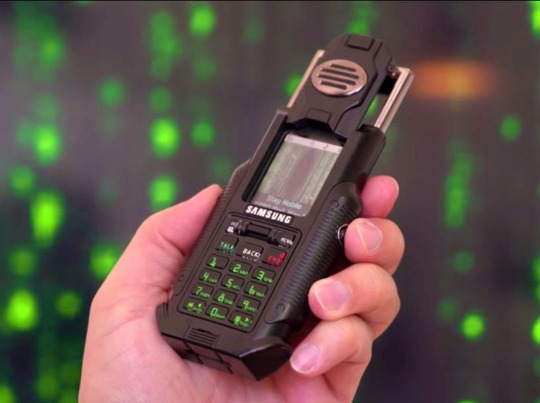
🇰🇷 Dive into the intriguing history of the Samsung SPH-N270, a handset that made waves in the mobile phone market!
📲 The Samsung SPH-N270 or Matrix phone is a bar style mobile phone released in 2003, made to resemble the phone used in The Matrix Reloaded. The design crew of the Matrix worked closely with Samsung to develop a phone whose features and release date would coincide with the movie.
📞 Sporting a sleek and futuristic form factor, the Samsung SPH-N270 featured a unique rotating keypad that could be swiveled open to reveal the phone's display. This innovative design allowed users to switch between keypad and touchscreen functionality with ease, offering a versatile user experience unlike any other handset on the market.
⚙️ Despite its compact size, the Samsung SPH-N270 packed a punch in terms of features and capabilities. Equipped with a vibrant color display, polyphonic ringtones, and an integrated camera, the SPH-N270 offered users a wide range of multimedia and communication options at their fingertips.
💪 The SPH-N270 was not intended as a mainstream phone for everyday use. Instead, it was marketed solely to fans of the series as a piece of rare, high quality merchandise. In the same time, the phone quickly gained popularity among tech enthusiasts and trendsetters, earning praise for its sleek design, intuitive interface, and reliable performance. Its unique rotating keypad became a signature feature of the device, setting it apart from competitors and solidifying its status as a standout handset in Samsung's lineup.
#old technology#techtime chronicles#companies#tech#technology#old tech#corporations#electronics#samsung electronics#samsung#sph-n270#the matrix#the matrix reloaded#movie#telecomindustry#matrix phone#south korea#made in korea#electronic#gadgets#device#mobile phones#cell phone#cell system#futuristic#design#y2k#y2k aesthetic#early 2000s#y2k style
5 notes
·
View notes
Text
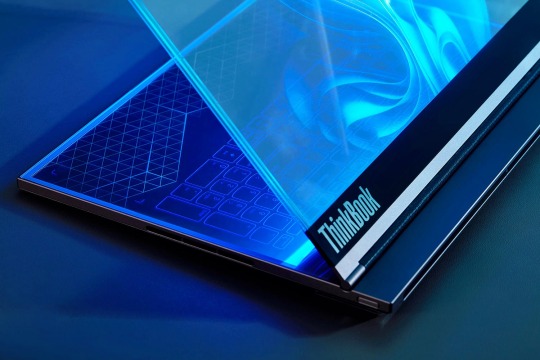


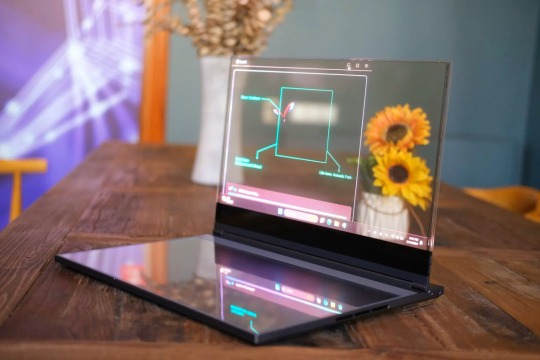
🇨🇳🤝🇺🇲 Introducing the futuristic Lenovo ThinkBook Transparent Display Laptop – a groundbreaking innovation that redefines the future of computing with its cutting-edge transparent display technology!
💻 Lenovo's long-announced transparent-screen laptop became a sensation at the 2024 Mobile World Congress (MWC). Renewed Lenovo ThinkBook represents a leap forward in laptop design and functionality. With its transparent OLED display, this revolutionary laptop offers users a truly immersive computing experience unlike any other. By seamlessly integrating digital content with the surrounding environment, the transparent display blurs the lines between the virtual and physical worlds, unlocking new possibilities for productivity, creativity, and collaboration.
⚙️ Powered by state-of-the-art hardware and software, the laptop delivers exceptional performance and versatility. Whether you're working on complex tasks, enjoying multimedia content, or engaging in virtual meetings, this innovative laptop provides the power and flexibility to meet your needs.
🌐 Designed for the modern professional, the renewed futuristic ThinkBook combines sleek aesthetics with advanced functionality. Its transparent display not only offers a unique visual experience but also enhances productivity by allowing users to interact with digital content in new and exciting ways.
💡 With its forward-thinking design and innovative features, the Lenovo ThinkBook Transparent Display Laptop is poised to revolutionize the way we work, create, and connect in the digital age. Get ready to experience the future of computing – transparently.
#techtime chronicles#companies#tech#technology#information technology#technews#corporations#electronics#lenovo#thinkpad#thinkbook#innovators#innovative#innovation#transparent display#china#made in china#industry#it#laptop#laptops#computing#computer science#computers#computer#hardware#design#concept#personal computer#think
4 notes
·
View notes
Text

🎉 Thank you @segadriven and everyone who got me to 25 reblogs! Explore the past, present & future of tech! 🚀


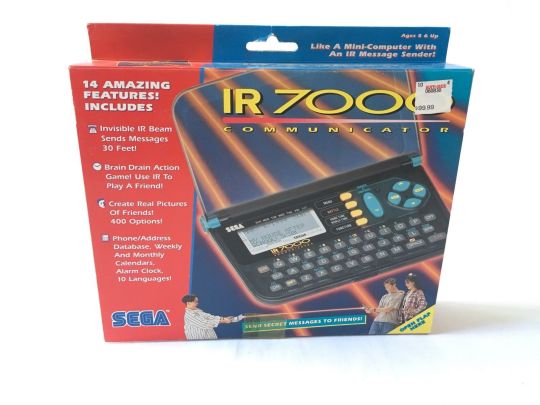
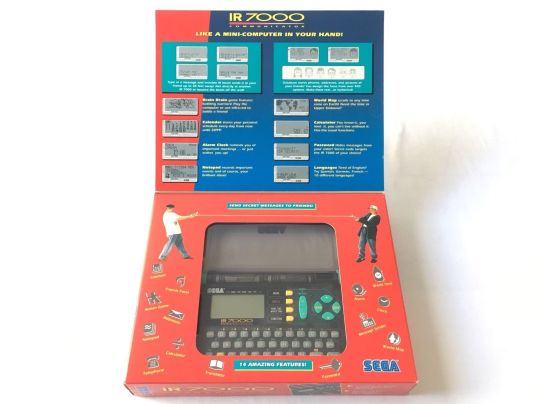
🇯🇵🤝🇺🇲 Step back in time to 1994 and explore the fascinating world of handheld communication with the IR 7000 Communicator—a groundbreaking device jointly crafted by Casio and Sega and released in the United States!
📟 As one of the pioneering handheld gadgets of its time, the IR 7000 served as a personal digital assistant, revolutionizing how users connected and communicated with each other. With its innovative infra-red beam technology, aptly named the "Magic Beam", users could exchange messages and engage in interactive activities like never before.
🎮 Beyond its communication capabilities, the IR 7000 was a versatile companion, offering a plethora of features to cater to various needs. From text messaging to immersive gaming experiences like "Brain Drain", the device provided endless entertainment. Additionally, its ability to create custom contact pictures and safeguard personal information with password protection added a layer of personalization and security.
⚙️ Bearing resemblance to other Casio models like the JD-6000 and JD-6500, the IR 7000 inherited familiar design elements and functionalities. While each model had its unique features, the IR 7000 stood out with its battle mode, setting it apart as a versatile and engaging handheld device.
🌟 Today, the IR 7000 remains a cherished testament to the ingenuity and innovation of its time, paved the way for the handheld communication devices we rely on today.
#25 reblogs#tumblr milestone#thank you#sega#ir 7000#gaming#retro tech#old tech#information technology#technology#tech#2000s tech#old technology#technews#computer science#companies#computing#computers#computer#y2k#sega cd#pda#personal digital assistant#telecommunications#gadgets#device#industry#innovators#innovative#innovation
19 notes
·
View notes
Text




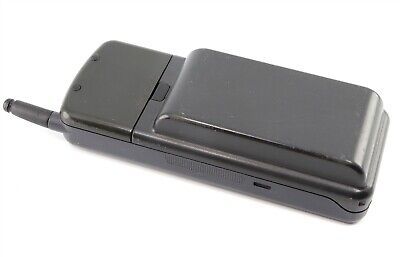

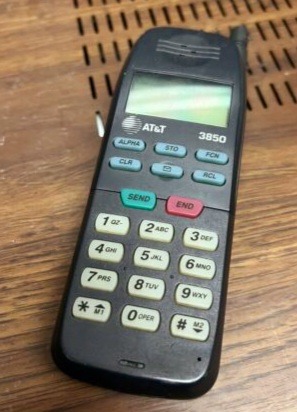
🇺🇸 Step back in time and delve into the fascinating history of AT&T's journey in the development and production of mobile phones! The AT&T Corporation (an abbreviation of its former name, the American Telephone and Telegraph Company) was a successor of the original Bell Telephone Company founded by the legendary inventor of the first practical telephone - Alexander Graham Bell in 1877.
👉 AT&T's division - Bell Laboratories, was created in 1925 from the consolidation of the R&D organizations of Western Electric and AT&T. Bell Labs made significant scientific advances, including the transistor, the laser, the solar cell, the digital signal processor chip, the Unix operating system, and the cellular concept of mobile telephone service.
🔍 AT&T's foray into the realm of mobile phones dates back to the early days of telecommunications. In the late 1940s, it embarked on pioneering efforts to develop mobile phone technology, laying the groundwork for future advancements in wireless communication.
💡 In the early years, AT&T, a huge telecommunications giant, focused on developing analog mobile phone systems, laying the groundwork for the future of wireless communication. Their first systems were limited to car phones, which required roughly 30 pounds of equipment in the trunk. These early devices were bulky and limited in functionality, but they represented a groundbreaking leap forward in telecommunications.
🏁 The first cellular phone was the culmination of efforts begun at AT&T Bell Labs and continued by Motorola Inc. While Motorola was developing the cellular phone itself, AT&T Bell Labs worked on the cellular system called AMPS. On April 3, 1973, Martin Cooper placed the first public call from a Motorola handheld portable cell phone to his counterpart Dr. Joel S. Engel at AT&T Bell Labs.
🏙 Advanced Mobile Phone System (AMPS) was an analog mobile phone system standard originally developed by AT&T Bell Labs and later modified in a cooperative effort with Motorola Inc. It was officially introduced in the USA on October 13, 1983. On this day, Bob Barnett, former president of Ameritech Mobile Communications, placed a call with a cell phone to the grandson of Alexander Graham Bell, who was in Germany for the event.
➡️ During the 1980s to 1990s, AT&T Corporation tried to achieve its place in the cell phone market and introduced some interesting devices: 3810, 3850, and 6650. Featuring sleek and ergonomic designs, they were a real testament to innovation and engineering excellence.
⚙️ Equipped with advanced features for its time, these phones boasted impressive functionality, including voice calling, text messaging, and address book capabilities. Their cutting-edge technology represented a leap forward in mobile communication, setting new standards for performance and reliability. These phones also ran on the AMPS 800 cell system.
📑 In 1996, AT&T spun off Bell Laboratories, along with most of its equipment manufacturing business, into a new company named Lucent Technologies. AT&T retained a small number of researchers who made up the staff of the newly created AT&T Labs. That meant the decline of future attempts at cell phone manufacturing by AT&T Corporation.
🌐 Today, AT&T continues to be a powerful multinational telecommunications holding company, offering a diverse range of cutting-edge services to consumers worldwide. With a rich legacy of innovation and a steadfast commitment to excellence, AT&T remains a leader in the ever-evolving landscape of telecommunications.
#old technology#techtime chronicles#companies#old tech#tech#technology#information technology#technews#corporations#electronics#at&t#bell labs#lucent#mobile phones#motorola inc#bell telephone company#american telephone and telegraph company#at&t corporation#cell phone#cell system#amps 800#alexander graham bell#car phone#telecomindustry#telephone#telecommunications#innovators#innovative#innovation#industry
4 notes
·
View notes
Text




🇯🇵🤝🇺🇲 Step back in time to 1994 and explore the fascinating world of handheld communication with the IR 7000 Communicator—a groundbreaking device jointly crafted by Casio and Sega and released in the United States!
📟 As one of the pioneering handheld gadgets of its time, the IR 7000 served as a personal digital assistant, revolutionizing how users connected and communicated with each other. With its innovative infra-red beam technology, aptly named the "Magic Beam", users could exchange messages and engage in interactive activities like never before.
🎮 Beyond its communication capabilities, the IR 7000 was a versatile companion, offering a plethora of features to cater to various needs. From text messaging to immersive gaming experiences like "Brain Drain", the device provided endless entertainment. Additionally, its ability to create custom contact pictures and safeguard personal information with password protection added a layer of personalization and security.
⚙️ Bearing resemblance to other Casio models like the JD-6000 and JD-6500, the IR 7000 inherited familiar design elements and functionalities. While each model had its unique features, the IR 7000 stood out with its battle mode, setting it apart as a versatile and engaging handheld device.
🌟 Today, the IR 7000 remains a cherished testament to the ingenuity and innovation of its time, paved the way for the handheld communication devices we rely on today.
#old technology#techtime chronicles#companies#old tech#tech#technology#information technology#technews#corporations#electronics#sega#sega corporation#casio#japan#made in japan#handheld communicator#communicator#brain drain#gadgets#device#electronic#digital assistant#pda#innovation#industry#usa#communication#messanger#magic beam#infra-red beam
19 notes
·
View notes
Text
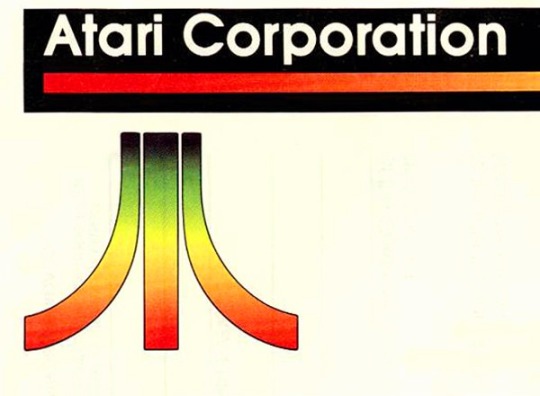






🇺🇲 Dive into the realm of computing nostalgia with a look back at the Atari Corporation's iconic personal computers—the Atari 400/800, Atari 520ST, and Atari Falcon! Introduced by Atari Corporation, a pioneer in the world of gaming and computing, these machines left an indelible mark on the landscape of home computing during their respective eras.
⌨️ The Atari 400 and Atari 800 made their debut in 1979, offering users a glimpse into the future of personal computing. With their sleek design and innovative features, including custom graphics and sound capabilities, these machines quickly gained a dedicated following among early computer enthusiasts.
🚀 Fast forward to 1985, and Atari unleashed the Atari 520ST—a groundbreaking computer that revolutionized the industry with its impressive performance and affordability. Boasting a powerful Motorola 68000 processor and advanced graphical capabilities, the 520ST became a favorite among musicians, artists, and gamers alike, earning a reputation as a versatile and reliable machine.
💻 In 1992, Atari continued its legacy of innovation with the introduction of the Atari Falcon—a high-performance computer designed for the next generation of computing enthusiasts. Featuring a Motorola 68030 processor, enhanced graphics and multimedia capabilities, and built-in MIDI support, the Falcon pushed the boundaries of what was possible in home computing at the time.
💾 The Atari 400/800 series was known for its distinctive membrane keyboard and cartridge-based software, while the Atari 520ST gained popularity for its compatibility with industry-standard software and peripherals, earning it a place in the hearts of musicians and creative professionals.
🕹️ Although the Atari Corporation's foray into personal computing was relatively short-lived, the legacy of the Atari 400/800, Atari 520ST, and Atari Falcon lives on in the annals of computing history, inspiring generations of technology enthusiasts and paving the way for future innovations.
#techtime chronicles#old computers#atari#atari corporation#companies#computing#computers#computer#computer stuff#innovation#industry#usa#made in usa#atari 400#atari 800#atari vcs#atari falcon#atari 520ST#computer science#computer accessories#basic#keyboard#hardware#software#motorola#processor#multimedia#graphic#old technology#old tech
10 notes
·
View notes
Text
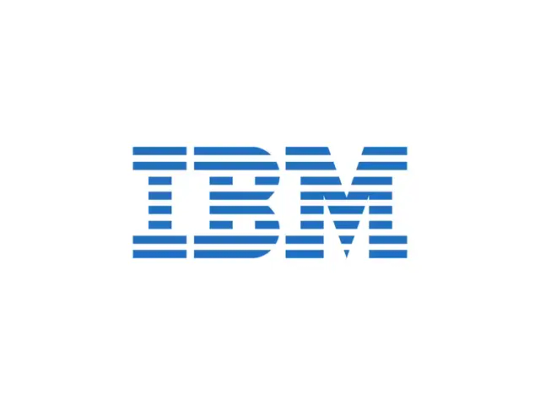
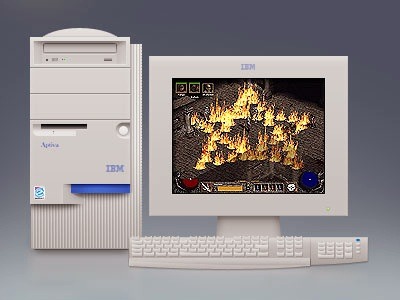

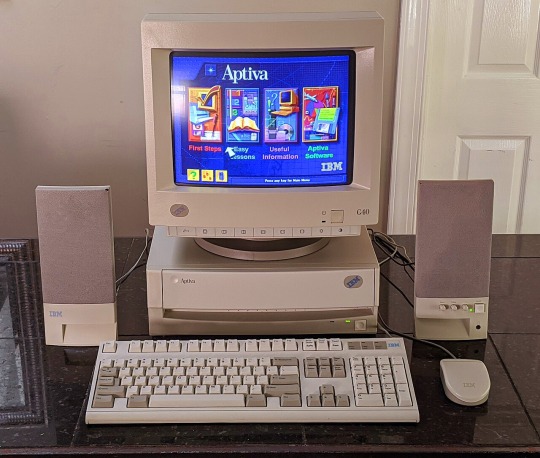
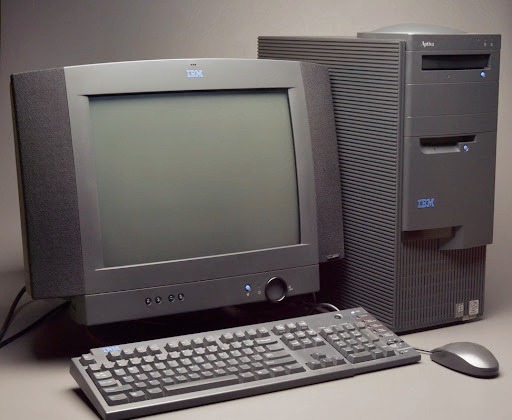




🇺🇲 Embark on a nostalgic journey through the fascinating history of the IBM Aptiva. Introduced by IBM, a global leader in technology innovation, the Aptiva series represented a bold leap forward in home computing, combining cutting-edge technology with user-friendly design.
💻 The IBM Aptiva made its debut in September, 1994, as the replacement for the IBM PS/1. With its sleek and stylish design, intuitive user interface, and powerful performance, the Aptiva quickly became a favorite among home users.
⌨️ Rooted in IBM's legacy of innovation, the Aptiva series showcased the latest advancements in hardware and software technology. The first Aptiva models were based on the Intel 80486 CPU. Later models used the Pentium and AMD CPUs. First-generation models came with DOS 6.3 and Windows 3.1. Pentium-generation Aptivas came with Windows 95 and OS/2 'select-a-system' (PC DOS 7/Windows 3.1 and OS/2 Warp) on selected models. Most models included a modem and a standby/hibernation feature called "Rapid Resume".
🌟 The IBM Aptiva was known for its innovative features, including built-in CD-ROM drives, sound cards, and modems, which were cutting-edge technologies at the time. Its user-friendly design and robust performance made it a popular choice for both work and play. From its state-of-the-art processors and expansive memory options to its vibrant graphics and immersive multimedia capabilities, each iteration of the Aptiva pushed the boundaries of what was possible in home computing.
⚙️ Over the years, the IBM Aptiva evolved to meet the changing needs of consumers, adapting to the rapid pace of technological innovation. From compact desktop models to sleek all-in-one designs, the Aptiva series offered a diverse range of options to suit every lifestyle and budget.
💔 The last Aptiva system was withdrawn from sale in May 2001 without a direct replacement when IBM decided to exit the home market. Customers were directed to the IBM NetVista, which was more targeted to business desktops.
#techtime chronicles#old technology#tech#technology#companies#old tech#information technology#technews#corporations#electronics#ibm#ibm pc#ibm aptiva#ibm pc1#1994#1990s computers#cd rom#old computers#computers#computer#computer stuff#computing#computer science#computer accessories#home computer#personal computer#ms dos#windows 95#os2#os/2
7 notes
·
View notes
Text






🇺🇲🤝🇬🇧 Step into the world of photography with the Kodak Ektra—a modern homage to the legendary 1941 Kodak Ektra camera, blending vintage charm with contemporary technology! Launched in 2016 and officially released in 2017, the Kodak Ektra (built by the british Bullit Group LTD) smartphone garnered a mix of reviews, sparking intrigue among photography enthusiasts.
🎞️ The original Ektra camera, introduced by Kodak USA in 1941, boasted advanced features such as the Medalist, Super Six-20, and Bantam Special models, captivating photographers worldwide before the outbreak of World War II.
📸 Tailored for shutterbugs, the Kodak Ektra phone boasted impressive specs, including a 21-megapixel rear camera with an f/2.0 lens, 6-axis optical image stabilization, PDAF, and a dedicated dual press shutter button. On the front, a 13-megapixel camera ensured stunning selfies and video calls. Plus, with RAW support and Advanced Manual Mode, users had full control over their photographic creations.
📲 Powered by Android 6.0, the Kodak Ektra housed a Helio X20 2.3GHz Decacore processor and 3GB RAM, delivering seamless performance for photo editing and multitasking. Its 3000mAh battery with USB 3.0 Type C fast charger ensured extended shooting sessions, while the 32GB expandable memory via MicroSD provided ample space for storing precious memories. All displayed on a vibrant 5-inch Full HD display, capturing every detail with clarity and precision.
#techtime chronicles#old technology#tech#technology#companies#old tech#information technology#technews#corporations#electronics#kodak#bullit group#kodak ektra#camera#phone#mobile phone#cell phone#android#camera phone#helio#full hd#design#brands#ektra#innovation#innovative#eastman kodak#usa#england#smartphone
1 note
·
View note